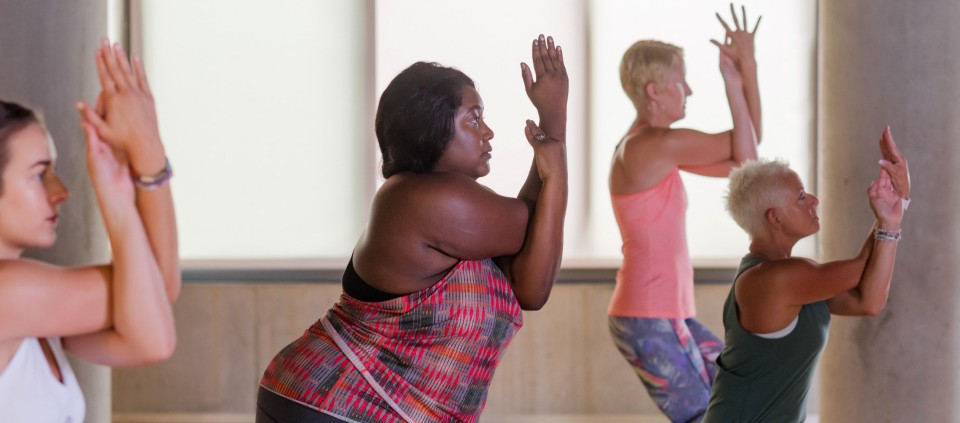How Yoga Can Help Soothe Anxiety

At one point or another, we have all had that feeling. The increased heart rate. The tightness in your chest. Your mind racing. And the desire to be anywhere but in your own body.
We all experience anxiety from time to time. In the proper dose, it can be channeled skillfully—the right amount of internal activation can help sharpen your mind and keep you focused and on task. But too much anxiety can wear down your body, nervous system, and brain, making optimal functioning difficult.
Can yoga be beneficial in those moments when anxiety hits a suboptimal threshold? Research sheds some light on how yoga might help release those anxious woes.
Yoga helps soothe a frazzled system.
Researchers theorize that yoga might help soothe an anxious nervous system by activating the relaxation response via the vagus nerve—the nerve that helps control the parasympathetic nervous system. This theory posits that yoga’s combination of slow movement and conscious breathing initiates a calming response in the nervous system, which can be measured via heart rate variability.
A study authored by Boston University researcher Chris Streeter suggests that another reason yoga can act as a calming agent it is ability to increase GABA, the neurotransmitter in the brain that helps relax the mind, producing the same benefits as Xanax. In this 12-week study, participants either walked or did yoga for an hour three times a week. The yoga group showed greater increases in GABA levels, and greater improvement in mood and anxiety.
While further research is necessary, these studies reveal some of the mechanisms through which yoga can reduce stress and anxiety.
Research on yoga for anxiety is promising.
Overall, the research thus far on yoga for clinical anxiety conditions, such as generalized anxiety disorder and panic disorder, is promising. Of particular interest is a recent study that compared a cognitive-behavioral therapy (CBT) intervention to a CBT intervention with a yoga component. The intervention consisted of a 100-minute weekly meeting for two months. For both groups, reductions were reported in anxiety and panic-related body sensations, but the changes were greater for those in the CBT-plus-yoga group.
Two single-arm studies (that is, studies without a control group), one that combined yoga with cognitive behavioral therapy and one that followed up on at least eight weeks of traditional treatment for anxiety, found that yoga improved symptoms of generalized anxiety disorder over time. In addition, a small study looking at Kripalu Yoga found that both the group practicing yoga and the control group showed decreases in PTSD symptoms.
Yoga has also been shown to reduce anxiety in those without psychiatric conditions. For example, one study showed that yoga helped reduce anxiety in people with cancer, while another study showed similar results for those trying to quit smoking.
Five Things to Remember About Yoga and Anxiety
If you’re planning to use your yoga practice to address anxiety, here are some important things to keep in mind.
Short, frequent practices are better than longer sessions less often. Don’t hold yourself back thinking that it’s not worth it unless you can do an hour-long practice. Often a shorter practice (even 10 minutes a day), done more often, can yield greater results than a longer one done just once a week.
Try different kinds of yoga. For some, a slow, gentle practice is the way to go. Many students enjoy a restorative or Yin Yoga class when they feel anxious. To soothe a harried nervous system, moving slowly (or not at all) can be the right reset. However, others need more intensity before they can relax. Try different approaches and see what works for you.
Find a calming space. Whatever you choose, practice in a space that is soothing to the nervous system—with a comfortable temperature, dim lights, and perhaps quiet music. Bright lights and loud music rarely support a calm nervous system.
Don’t underestimate the power of breathing. Simple breathing techniques, such as Dirgha pranayama or slow breathing with a focus on the exhale, can be powerful additions to your anti-anxiety tool kit. And don’t wait to practice a calming breath until you are in the throes of anxiety. Try to practice at other times, too. In doing so, you will help to train your body and mind to activate the relaxation response when you begin your slow breathing.
The effects of yoga on anxiety can take time and continued practice. Depending on how longstanding your anxiety is and how severe it is, the positive effects of yoga can take some time. Most of the studies cited above yielded improvements after two to three months of at least a weekly practice. Retraining your nervous system is like learning a new hobby. You would not expect to be an expert guitar player the first time you play the guitar. Or even the tenth time. It takes practice and dedication to learn the skill of yoga and to allow your body and nervous system to reset. In addition, some students go through a period of some discomfort, both mentally and physically, before coming out the other side and starting to find relief. Be patient with yourself and with the practice.
Angela Wilson, LMHC, RYT 500, is a Kripalu faculty member who has conducted research and written about the intersection between yoga, Western psychology, and science.
Full Bio and Programs